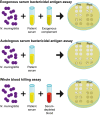Multi-component meningococcal serogroup B (MenB)-4C vaccine induces effective opsonophagocytic killing in children with a complement deficiency
- PMID: 31487400
- PMCID: PMC6857189
- DOI: 10.1111/cei.13368
Multi-component meningococcal serogroup B (MenB)-4C vaccine induces effective opsonophagocytic killing in children with a complement deficiency
Abstract
Vaccination against meningococcal serogroup B is recommended for patients with a complement deficiency; however, although immunogenicity in this patient group has been shown, efficacy has not yet been established. In this study, we collected serum from children with a complement deficiency in the alternative pathway or in late terminal pathway before and after vaccination with multi-component meningococcal serogroup B (MenB)-4C. MenB-4C is a multi-component, protein-based vaccine against MenB consisting of factor H-binding protein, Neisserial heparin-binding protein, Neisserial adhesion A and outer membrane vesicles containing Porin A. We assessed the vaccine immunogenicity and vaccine-mediated protection by a whole cell enzyme-linked immunosorbent assay with Neisseria meningitidis serogroup B strains H44/76, 5/99 and NZ98/254, which shows that vaccination induced antibody titers against meningococcus. We show that the classical serum bactericidal activity assay with exogenous serum indicates the presence of vaccine-induced antibodies and capacity to activate complement-mediated pathogen lysis. However, in children with a late terminal pathway deficiency, no complement-mediated pathogen lysis was observed when autologous serum was applied in the serum bactericidal activity assay, demonstrating a lack of serum bactericidal activity in children with complement deficiencies. However, MenB-4C vaccination still induced effective complement-dependent opsonophagocytic killing against N. meningitidis serogroup B in reconstituted whole blood with autologous serum from children with an alternative pathway or late terminal pathway deficiency. These findings support the recommendation to vaccinate all complement-deficient children against MenB.
Keywords: Neisseria meningitidis; MenB-4C; children; complement-deficient; vaccine.
© 2019 The Authors. Clinical & Experimental Immunology published by John Wiley & Sons Ltd on behalf of British Society for Immunology.
Conflict of interest statement
The authors declare that they have no conflicts of interest
Figures




Similar articles
-
A Meningococcal Outer Membrane Vesicle Vaccine with Overexpressed Mutant FHbp Elicits Higher Protective Antibody Responses in Infant Rhesus Macaques than a Licensed Serogroup B Vaccine.mBio. 2019 Jun 18;10(3):e01231-19. doi: 10.1128/mBio.01231-19. mBio. 2019. PMID: 31213564 Free PMC article.
-
Anti-Factor H Antibody Reactivity in Young Adults Vaccinated with a Meningococcal Serogroup B Vaccine Containing Factor H Binding Protein.mSphere. 2019 Jul 3;4(4):e00393-19. doi: 10.1128/mSphere.00393-19. mSphere. 2019. PMID: 31270173 Free PMC article. Clinical Trial.
-
Use of expanded Neisseria meningitidis serogroup B panels with the serum bactericidal antibody assay for the evaluation of meningococcal B vaccine effectiveness.Expert Rev Vaccines. 2023 Jan-Dec;22(1):738-748. doi: 10.1080/14760584.2023.2244596. Expert Rev Vaccines. 2023. PMID: 37622470 Review.
-
Bactericidal antibody against a representative epidemiological meningococcal serogroup B panel confirms that MATS underestimates 4CMenB vaccine strain coverage.Vaccine. 2013 Oct 9;31(43):4968-74. doi: 10.1016/j.vaccine.2013.08.006. Epub 2013 Aug 14. Vaccine. 2013. PMID: 23954380
-
Meningococcal serogroup B vaccines: Estimating breadth of coverage.Hum Vaccin Immunother. 2017 Feb;13(2):255-265. doi: 10.1080/21645515.2017.1264750. Epub 2016 Dec 14. Hum Vaccin Immunother. 2017. PMID: 27960595 Free PMC article. Review.
Cited by
-
Alternative Complement Pathway Inhibition Abrogates Pneumococcal Opsonophagocytosis in Vaccine-Naïve, but Not in Vaccinated Individuals.Front Immunol. 2021 Oct 11;12:732146. doi: 10.3389/fimmu.2021.732146. eCollection 2021. Front Immunol. 2021. PMID: 34707606 Free PMC article.
-
The contribution of the alternative pathway in complement activation on cell surfaces depends on the strength of classical pathway initiation.Clin Transl Immunology. 2023 Jan 27;12(1):e1436. doi: 10.1002/cti2.1436. eCollection 2023. Clin Transl Immunology. 2023. PMID: 36721662 Free PMC article.
-
Recommendations on vaccination in children and adolescents with inborn errors of immunity according to the expanded Colombian immunization program.Biomedica. 2024 Dec 23;44(Sp. 2):220-235. doi: 10.7705/biomedica.7424. Biomedica. 2024. PMID: 39836851 Free PMC article. Review. English, Spanish.
-
Eculizumab impairs Neisseria meningitidis serogroup B killing in whole blood despite 4CMenB vaccination of PNH patients.Blood Adv. 2020 Aug 11;4(15):3615-3620. doi: 10.1182/bloodadvances.2020002497. Blood Adv. 2020. PMID: 32766853 Free PMC article.
-
Evaluating Functional Immunity Following Encapsulated Bacterial Infection and Vaccination.Vaccines (Basel). 2021 Jun 20;9(6):677. doi: 10.3390/vaccines9060677. Vaccines (Basel). 2021. PMID: 34203030 Free PMC article.
References
-
- Skattum L, van Deuren M, van der Poll T, Truedsson L. Complement deficiency states and associated infections. Mol Immunol 2011; 48:1643–55. - PubMed
-
- Rosain J, Hong E, Fieschi C, Martins PV, El Sissy C, Deghmane AE. Strains responsible for invasive meningococcal disease in patients with terminal complement pathway deficiencies. J Infect Dis 2017; 215:1331–8. - PubMed
-
- Parikh SR, Andrews NJ, Beebeejaun K et al Effectiveness and impact of a reduced infant schedule of 4CMenB vaccine against group B meningococcal disease in England: a national observational cohort study. Lancet 2016; 388:2775–82. - PubMed
MeSH terms
Substances
LinkOut - more resources
Full Text Sources
Miscellaneous

